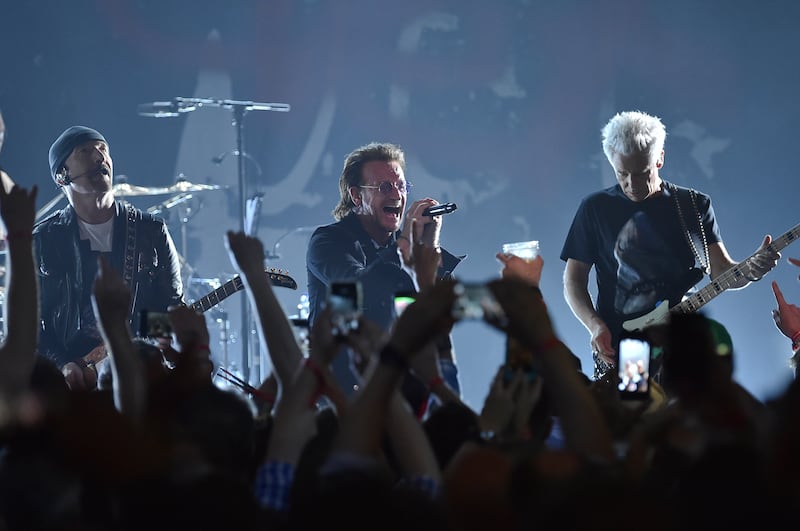The radiation oncology department in the basement of Mount Sinai Hospital in New York does not seem like a regular home for rock’n’roll. But every business day for almost seven weeks this year, U2 blared over the speakers at my request.
I became a fan in the late 1980s and have attended nine of the band’s concerts, though I probably fall short of superfandom. I remember listening to songs from the Joshua Tree album as a preteen on my staticky clock radio, struck by U2’s carefully crafted music that builds into anthems, and lyrics exploring weighty but personal themes, like love and religion.
In the 1990s I watched their mesmerising Zoo TV tour in the pouring rain from the nosebleed seats of the old Giants Stadium in New Jersey. My wife, Amy, and I danced to In a Little While at our wedding. In many ways the group has provided the soundtrack to my life.
That importance gained new dimension in the summer of 2022, when I was diagnosed with a benign tumour the size of a lime near my pituitary gland. I had surgery to remove it, only to develop a rare bleeding complication that left me in intensive care for about a week. I required emergency transport and five units of blood to survive.
READ MORE
While my complication (thankfully) is on track to heal, a small bit of the tumour remains. In March I finished a 30-session radiation cycle to keep the mass from growing again. All of my medical drama led to dozens of trips to Mount Sinai. And it brought many chances to request U2.
Patients undergoing recurring care like radiation sometimes get their choice of music, which makes it easier to relax and keep still. Meditative or classical music are popular choices, according to the radiation technicians at Mount Sinai. My choice was slightly different.
One part, of course, was escape. At every treatment, for weeks upon weeks, I changed into a gown, lay on a table and had a suffocating mesh plastic mask installed on my head to ensure that I would not move or twitch. The MRIs required absolute stillness for up to 35 minutes or more.
[ U2: Songs of Surrender – A cynical cash grab? Put your preconceptions asideOpens in new window ]
Hearing U2 helped, especially in the latter parts of the radiation treatment, when the routine became harder to bear. Bono’s philosophical words, Adam Clayton’s steady bass, Larry Mullen Jnr’s crisp drums and the Edge’s ringing guitars – that was my focus. U2’s songs often surfaced memories that took me far from the treatment room: a high-school trip (I Still Haven’t Found What I’m Looking For), a college break-up (One), time spent in another city (Beautiful Day).
The music also served a utilitarian purpose. U2’s songs routinely clock in at about four minutes long. That knowledge allowed me to estimate how much of the treatment remained. Radiation typically took me about 20 minutes, or four to five U2 songs. MRIs lasted about eight songs.

At the initial MRI that kicked off my medical journey I had no idea that music was even an option. Holding still in silence, the MRI seemed to take aeons to complete as the machine heated up and emitted ominous loud beeps and crackles. At my second scan I asked about the possibility of audiobooks or music. Yes, they had Spotify, a technician said. My U2 treatment plan was born.
During my many trips to Mount Sinai I have heard music from the band’s five-decade catalogue in random order. Sometimes I reframed the songs in light of my circumstances. Stories for Boys (1980) made me think of my six-year-old son and how I hoped to raise him longer. Ultraviolet (Light My Way) (1991) and Kite (2000) brought about thoughts of my 11-year-old daughter. Every Breaking Wave (2014) took me to a sunny beach. With or Without You (1987) popped up most often, sparking a feeling one might get if a best friend just walked into the room.
[ Ultimate U2: The Irish rock giants’ 20 best tracks, in orderOpens in new window ]
Every once in a while Spotify sent out a song that I had not heard before, often a B-side or an obscure dance version of a track. (How many times did the band rearrange Mysterious Ways?) For my fifth MRI the technicians mistakenly put on a karaoke version of a U2 album with no words. Luckily, the songs were a close-enough facsimile of – though definitely not even better than – the real thing.
The song that induced the most catharsis during treatment? Where the Streets Have No Name. With its ethereal organ and guitar and racing beat, the song conjures images of speeding down an empty desert highway. Basically, the opposite of lying in a hospital bed.
[ U2′s The Edge: ‘I’ve always got an eye out for food that’s not highfalutin’Opens in new window ]
Life’s saving graces come in all sizes, with the small ones often accumulating and surprising us with their bigness when we least expect it. I think about the village of people that helped me during this health crisis. Doctors, nurses, support staff, family, friends, colleagues. My wife, especially. Count U2 among them. – This article originally appeared in The New York Times













